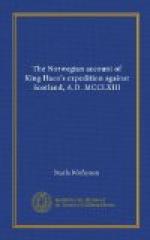[Footnote 70: Rudri or Ruari is the Irish abbreviation of Roderic. The person here meant is, no doubt, the second son of King Reginald, & the same who in a donation to the abbey of Sandale, is stiled Rodericus de Kintire filius Reginaldi. This Roderic, it seems, besides Allan & Dougal, had another son Angus McRorie, Lord of Bute, whose daughter and heiress Jean was married to Alexander sixth Lord High Steward, Grand father to Robert II. King of Scotland. Robert, A.D. 1400., gave Bute to his son John from whom the present family of Bute is lineally descended.]
[Footnote 71: i.e. the Scotch.]
[Footnote 72: i.e. the Scotch.]
[Footnote 73: i.e. sea.]
[Footnote 74: i.e. ships.]
[Footnote 75: Irar. (orig.), i.e. Irish. As the native Irish had suffer’d so much from the Scandinavians it is improbable they would apply for assistance to the Siol Lochlin na beum. We may therefore reasonably conclude that the People here mentioned were the descendants of those Norwegians or Ostmen, who long inhabited the eastern coast of Ireland and founded some of its best towns. A. D. 1201 those Ostmen or Easterlings were still so considerable that, at a recognition taken of the diocese of Limerick, the arbitrators consisted of 12 English, 12 Irish, & 12 Ostmen. Edw. I. gave Gilchrist, William, & John Gilmorys, with other Ostmen in the County of Waterford, peculiar privileges; &, by the rolls of Edw. II. they evidently subsisted, as a distinct people, during the reign of that prince.]
[Footnote 76: Kumr-eyiar (orig.), i.e. the Islands of the Cumbrians, two small islands to the West of Scotland.]
[Footnote 77: Skipa-fioerd in Islandic, and Loch-Lhong, in Gaelic, signifies the Bay of Ships.]
[Footnote 78: Allan & Dougal his brother were, I imagine, the sons of Rudri (see the note on page 34.) This Allan we may suppose to be the same who, in Rymer’s Foedera, is called “Alanus filius Rotherici,” & who A. D. 1284 was one of the Barons that engaged to support Margaret of Norway’s title to the crown of Scotland. Dugal was probably the predecessor of McDougal of Dunoly i.e. Olave’s tower. The place might receive this name, from having been the residence of Olave, the youngest Son of Somerled thane of Argyle.]
[Footnote 79: To avoid long, or dangerous circumnavigations, it was usual for the antients to draw their light canoes over isthmuses. Among the Greeks such places were termed [Greek: diolchoi] i.e. dragging-places, and there was a very remarkable one near Corinth. By the Scotch they were called Tarbats, from the Gaelic tarn to draw, and baat a boat. There was a Tarbat between Loch-Lomond and Loch-Long.]
[Footnote 80: Alwin McArkel, as appears from the Chartulary of Glasgow, was created Earl of Levnach by Maol-Coluim IIII., A. D. 1153.]




